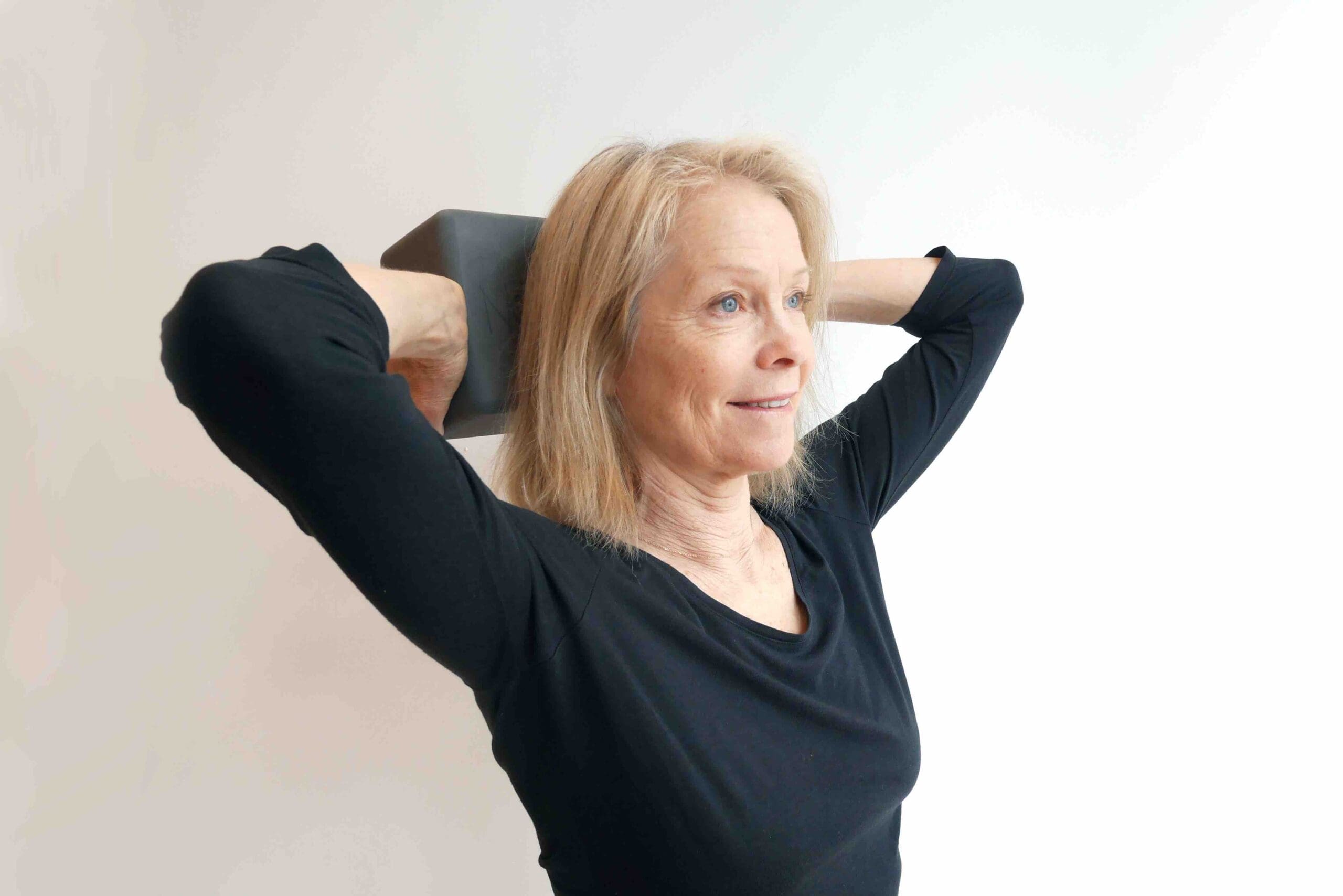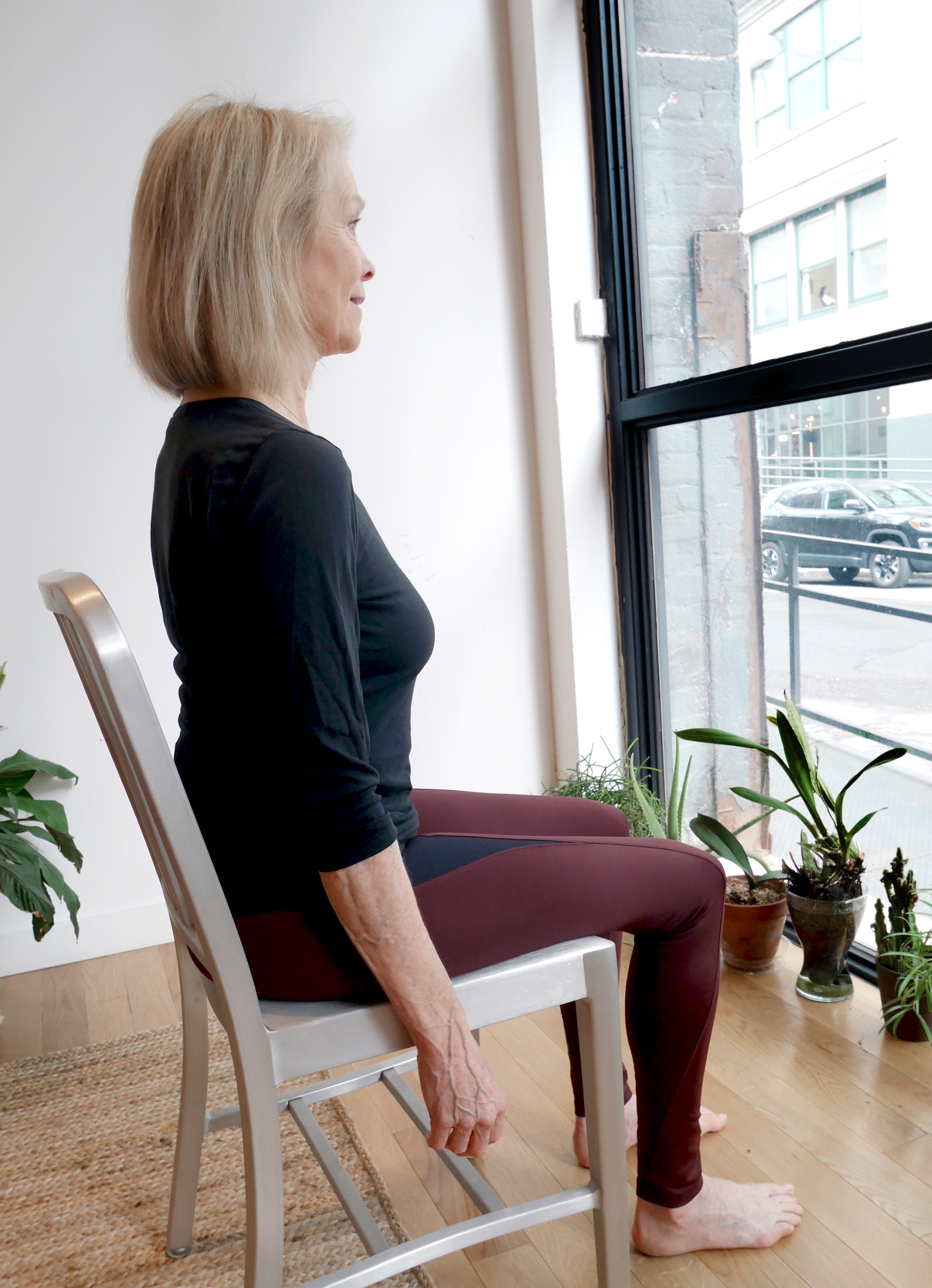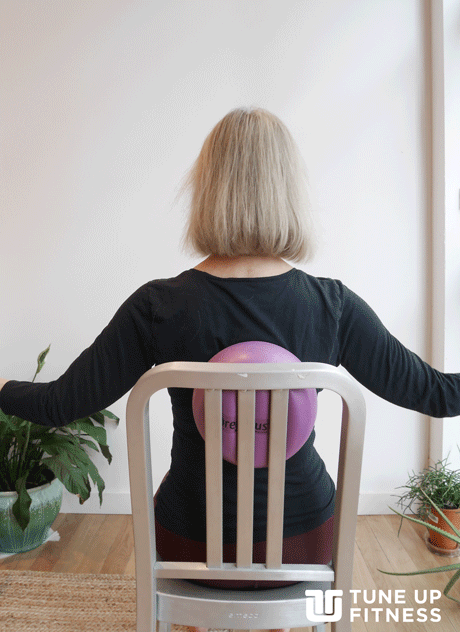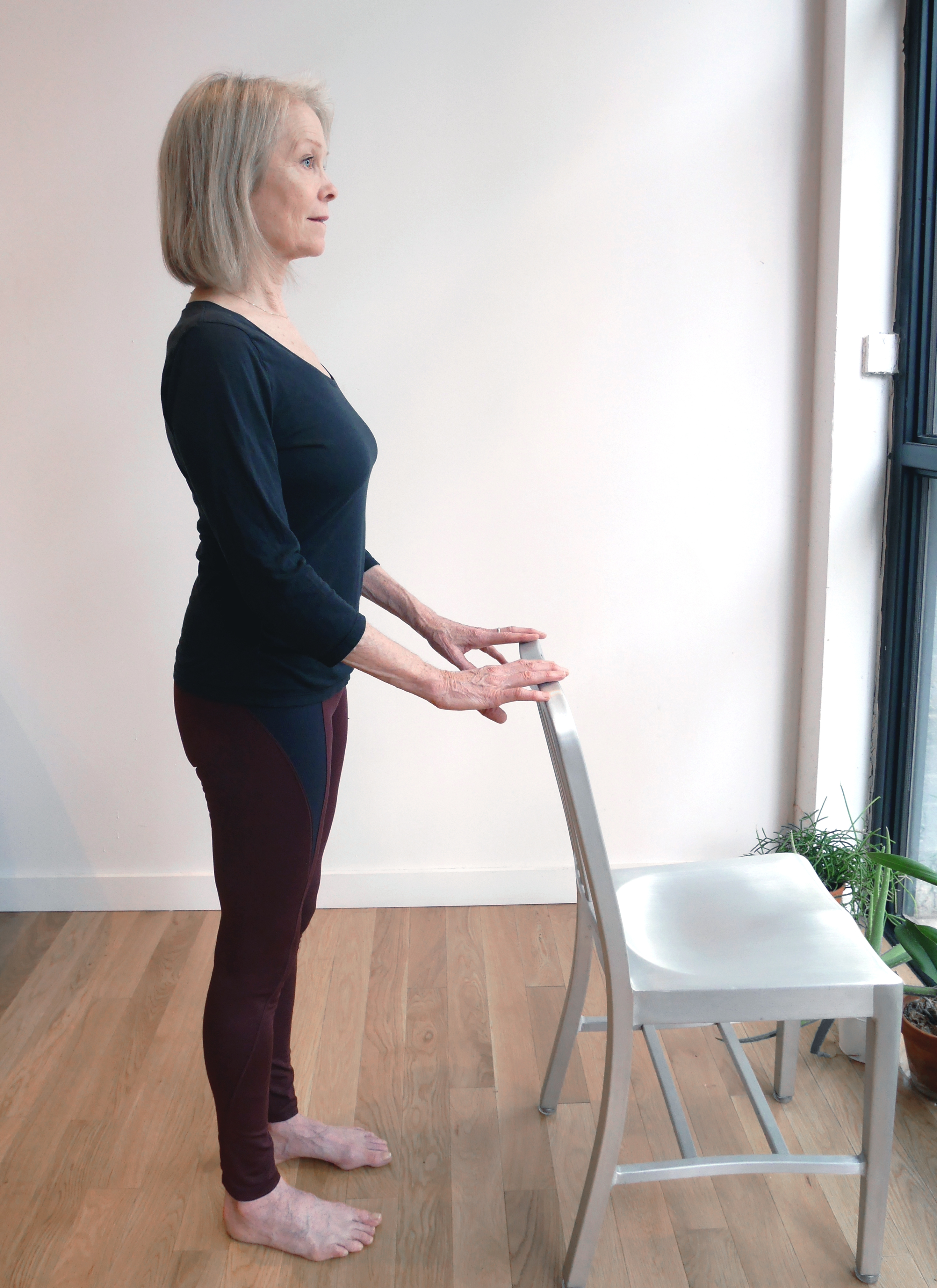
“The stereotype of older people is changing. The stereotype, where your life is done at 65, is changing. There’s a whole new lifespan and integrity around being an older person and I want to be a front-runner in that.”
New York City actor/acting teacher/director/playwright Grace Kiley is our “Roll Model” this week. Kiley is on the young end of the senior category–and committed to staying flexible and fit for years to come.
“I’ve seen some people who are quite elderly and have this beautiful straight posture and it’s so impressive,” says Kiley. “I want to be one of those people. I want to stay elegant, upright, and looking up, not looking down at the sidewalk.”
Posture for Happiness and Independence
For Kiley, posture and balance are imperative for her health, independence, and happiness.
“When I’m upright I bring confidence to my work as a teacher and as an actor,” shares Kiley. “To take command of both big theatres and small intimate groups, I need to stay centered in my core, with my shoulders and head upright. My posture determines the energy I bring to my work.”
“There are also the daily tasks of carrying bags of props and books, plus climbing stairs around New York City and riding the subway,” she continues.
Kiley will often spend weeks traveling to teach or perform. “I’m an independent person and I need to be able to continue living independently because I find great joy in that.”
Below you will find Kiley demonstrating a practice of balance and posture exercises for seniors designed by Tune Up Fitness® instructor Katie Alba.
Balance Exercise Sequence for Seniors
Katie alba designed this sequence to enhance balance and poise for seniors.
“The number one concern I hear about working as a wellness director in an independent living facility is the fear of falling,” shares Alba. “There are many reasons falling occurs including changes in hearing and vision which happen naturally as we age. According to the CDC one in four adults, age 65 and older, fall each year.”
This sequence will help enhance strength, flexibility, and neuromuscular control with the support of the chair to make it a bit more senior-friendly.
1. Seated Poise
This seated pose will provide a great base to start and subtly strengthen the postural muscles along your spine.
- Sit upright in a chair with your feet evenly on the ground.
- Balance your weight symmetrically over your ischial tuberosities (sometimes called “sit bones”).
- Hang your arms down by your sides.
- Lengthen your spine, imagining a straight line running from the base of the pelvis up through the crown of your head.
- Maintain your posture and take 20 long, full breaths.

2. Mid-Back Massage
This exercise, using a Coregeous® sponge ball, will loosen up tight muscles along the spine, and “wake up” those posture muscles so they can hold you upright.
- Place a Coregeous® sponge ball, partially deflated, between the back of a chair and your lower ribcage.
- Reach your arms out to the sides, palms up (to open the chest and shoulders).
- Move your body right to left so that the therapy ball massages side-to-side across your back.
- Continue for approximately 2-3 minutes, or until you feel warmth, release, and ease in your back.


3. Seated Foot Self-Massage
“Another reason we lose balance is muscle deterioration,” warns Katie Alba. “Because the body is a ‘use it or lose it’ mechanism, enjoying the slower, less active lifestyle of the golden years can speed up that degeneration process.”
Alba continues, “While all this is a serious and scary subject there are things to help us stay strong and agile as we age.”
Massaging the soles of the feet on the original sized Yoga Tune Up® therapy balls is an effective way to stimulate the sensors on your feet to become more balanced and agile.
- Sit upright on a chair, with a therapy ball under each foot.
- Roll your feet forward and backward, dipping your toes, then your heels to the floor.
- Continue for 2 minutes, until a tingly warm feeling spreads under the soles of your feet.

4. Outer Hip Strengthener
Maintaining strong, flexible muscles around your hips is vital to prevent falls, or reduce the injury caused by falls.
According to Katie Alba, “One in five falls causes serious injury like a head injury or broken bones. More than 40% of individuals hospitalized from hip fractures do not return home and are not capable of living independently again.”
The Outer Hip Strengthener is a great exercise for flexibility, strength and motor control around the hip joints.
- Stand with hands braced on a chair or other surface while keeping the spine long and head lifted.
- Place feet parallel.
- Lift one foot an inch off of the floor and reach it straight out to the side without changing the parallel orientation of your feet.
- Maintain a neutral spine and a strong torso.
- Replace foot and repeat 10x.
- Do the other side.

5. Head Ramping
One of the first indicators that you are headed toward postural issues, is your head gets stuck in a forward-reaching position. The strain this puts on the upper back and shoulders can be immense, and cause the whole upper body to gradually collapse.
This is a simple, yet challenging exercise to help train you to “keep your head on your shoulders.”
- Sit or stand upright with your head level over the spine.
- Keeping your eyes fixed on the same point straight ahead, reach your head forward an inch or two.
- Pull your head straight back, keeping your eyes level.
- Repeat 10-20 times.

6. Neck Reset With a Block
To continue training the muscles of the upper back and neck to keep you upright, add a block behind the head. In Tune Up Fitness® we call this Blockhead.
- Stand or sit upright, with the spine in long, neutral curves.
- Hold a block behind your head.
- Lightly press the back of the head into the block (about 20% effort).
- To enhance this exercise, do the head ramping with the block. (see images below).
- Take the block away and notice if it feels easier to “keep your head on your shoulders.”


7. Standing Poise
To finish this balance exercises for seniors routine, check in with your posture once more.
- Stand upright with fingertips lightly touching a chair
- Parallel foot position just under hips
- “Joint stack” your hips over your heels, your shoulders over your hips, your ears over your shoulders.
- Gaze straight ahead at the horizon.
- Envision your bright future!
Find more information about instructor Katie Alba HERE.
Author and images: Ariel Kiley. (Yes, Grace is my mother and with her incredible spirit and practice, she seems to get younger every year!)
Related Article: Myofascial Self-Massage: Less is More
Learn more about our Therapy Ball Products and Programs
Interested in video and blog content targeted to your interests?











I’m seeing a lot more of this population and I appreciate all the different/ simple uses of a chair that can help with posture, balance, strength and stability. I’m going to start my mom on this specific routine when I see her next week! 🙂
This type of self care is important for everyone, but especially as we age. I just gifted my mom a full set of YTU balls for her 80th birthday, and we plan to go over a new rollout and exercise sequence together by zoom every 2 weeks.
This was such a pleasure to read! I am looking to help middle-aged women maintain and improve their strength and mobility in hopes to improve their quality of life as they age. My mother is a geriatric nurse and I watched the residents with interest as some were quite independent while others were completely reliant on others to survive. As a young dancer I mentored by many middle aged – elderly teachers who could still do incredible things with their bodies and were still living independently with fantastic, fulfilled lives. Thank you for sharing these subtle exercises for better posture! I hope to implement some of these into my daily practice!
These are really great options for older people especially to counteract kyphotic posture. I love the perspective of the writer speaking about the confidence and commanding presence that comes with good posture.
I just love this article and shedding some light on age being just a number :). I love how this was mentioned “The importance of posture and balance are imperative for her health, independence, and happiness.” As this statement is so powerful and true. The exercises are especially helpful and can be done by anyone at any age. Great read!
I like the exercise of using the corgeous ball and rolling side to side on a chair – not only does it “massage ” the back, but it is increaseling mobility and movement of the hips, takes some core strength, etc. I would do all of these exercises teaching a senior class.
What an awesome, accessible sequence for seniors with balance issues!!! I love finding ways to encourage independent movement for this demographic — and I’m especially excited to add neck ramping into some of my go-to pain-free posture sequences.
I love this article! such simple exercises that can make such a HUGE impact on someones life. I can’t wait to implement these exercises with some of my clients 80 clients. It would also be great “homework”!
I can really appreciate the simplicity of some of these exercises for older people who are less motivated because they already have balance deficits. The blockhead exercise and the lateral shifting are my favorites that I am excited to share with patients.
very helpful suggestions for seniors. I wonder what aging will look like if we practice these simple movements daily? perhaps the stereotypes of hunched over aged person will start to become the exception, not the rule.
Those are great exercices to improve posture.
This is still my favorite blog. I work with older clients and this blog reminds me to encourage mindful movements keep us safe.
Great great article! These exercises are super easy and so accessible ❤️
Great article! I have quite a few seniors who come to my fitness classes and I am excited to incorporate these moves to help them be more secure in their movement. Thanks for sharing!
Great sequence for my seniors! Thank you. Especially love the Coregeous Ball work on the back. I find That with most of the seniors I work with, the smaller balls are a bit too harsh at first.
Love the balancing poses because it teaches stability of the hip and core as well.
Thanks!
These are great moves not just for seniors, but could be used to help those with disabilities or for those in recovery as well. Fantastic work!
These are genius and accessible moves for a few of my senior clients! I love the mid-back massage. I was doing something similar with a yoga block but the ball coupled with the side the side motion really helps with mobility and proprioception. Thanks for this!
Thank you so much for the sequence.
I love these simple exercises/poses introduced in this article! I myself teach classes to the senior population, and one group is required to perform the entire class from a chair due to concerns over balance. I’m always looking for new creative exercises to include in class, and I’m especially excited to try the neck reset with a block and the head ramping. Head control is so important!
“There’s a whole new lifespan and integrity around being an older person and I want to be a front-runner in that.“ I love this beautiful quote. There is truly so much value in all ages of life. I will save this sequence for a class with some ladies who will benefit greatly from this.
This is wonderful one of the populations I teach is a group of mostly retirees and one of their biggest concerns is balance. I look forward to trying this poses myself and incorporating them with some of my older population.
I was very interested in reading this article because I teach yoga to older adults and I agree with Kiley that their main objective practicing yoga is to take care of their health, so they can remain independent and be able to perform their daily activities for theirself, feeling useful and so happy Furthermore, by improving their coordination and keeping the hip muscles strong and flexible they can prevent falls or prevent the lesion from becoming greater if they fall, since hip fracture is very common among older adults. Another benefit is that when making new movements they build neural bridges. I really liked Katie’s Tune Up Fitness® chair sequence, as it promotes strengthening, flexibility and neuromuscular control, so I will use it in my next class !!
I really enjoyed reading this article, the techniques shared are so simple and at the same time so powerful !!! Its is great that we have in our own hands the power to live a better senior lifeand also to help others. Thanks for sharing 🙂
Helping older people or making them aware that they can continue to mantain their posture and flexibility its a very important thing to do. During many generations before us, society has had a thought of fear towards aging and all because of the mindset that if you become older you won’t be able to move again, this is so not true, just because you age it doesn’t means that you would lose all your body mobility by the contrary if you continue putting effort and mobility to your body creating a discipline of excercise during your life, yes you will age but gracefully.
i love this article! this is one of the reasons why i changed the way i am practicing, because i want to have a healthy, mobile body when i become a senior, also to help others to recover their mobility and independence of their movement to be happier.
Me encantó leer este artículo, siento que es muy enriquecedor leer testimonios como el de Grace, si tenemos la dicha de tener una larga vida , todos pasaremos por el proceso de envejecer, elegir cómo y de qué manera lo hacemos es una elección que a la vez, determinará cada uno de nuestros días. La secuencia es maravillosa, voy a compartirla con mis seres cercanos tan queridos. Gracias!
I love this post. I want to use these exercises with my mom, who fell last year and is still recovering from spinal fractures. She’s tentative when she walks because, of course, she’s afraid of falling. I think she’ll like these poses. I love the language you use – I think it really works for seniors.
Watching my mother suffer from arthritis and most of her joints replaced makes me want to become proactive in strengthening my posture and my muscles to sustain my body frame and pay attention to balance
I teach chair yoga and, because classes are during the day, they often attract an older clientele. A portion of the classes is always dedicated to balance and posture as this is so important for all of us. I appreciate the well-rounded sequence you put together. The standing pose is interesting as there is often someone suffering from vertigo. Thanks.
Teaching chair yoga during the day generally attracts an older crowd. Focusing on posture and helping them to be more mindful of it throughout the day is so important. I appreciate the well-rounded gentle sequence you put together that is easy for students to practice on their own as well.
Ooh what a great chair yoga sequence with a powerful focus on building blocks of posture. I’m hoping to start a chair yoga class at my local studio – thank you for the great ideas!
Lovely sequence, for seniors or those recovering from injury or illness (such as vertigo) and needing modifications.
A great blog and just what I was looking for as I am in the process of putting together a video sequence for my parents. Am particularly looking for sequences for the knees as my mom has had both replaced and had issues with ligament and muscle scarring.
This article was very informative!! “According to the CDC one in four adults, age 65 and older, fall each year.” This is what it’s all about! What movement patterns can we create for ourselves so that we can live strong, healthy, independent lives when we get older? My number one goal is to figure out how to age gracefully and help others do the same. While I was reading, I caught myself slumped over my desk. I’ve caught myself following into this pattern a lot today while attending class. So, I immediately tried out the exercises above and loved the one using the Coregeous ball on the chair! This is now my new favorite thing and it makes it much easier to sit upright when spending long hours on schoolwork. I’ll be sharing this with my family and students!!
I love the idea that the life is not done at 65! I teach group fitness and my class students belong to different age categories. And I observe that age is just the number because if you take care of your body, eat well and exercise you can achieve a better result than someone 20 years younger. The secret how you feel is hidden in your mind and spirit and balance. I like presented in the article examples of exercises.
Great article, great sequence! Not only will this help me when working with private clients who are seniors, it also gives me great context for why certain movements are important in my normal asana classes. Thank you so much!
Love the simple balance and movement ideas that are user-friendly for people to do at home, seated or standing, accounting for mobility limitations and they can be easily inserted into their day.
I would venture to guess that 2/3 of my regular group class students would be considered seniors. One recently completed a triathlon, a few have better core strength and awareness then students in their 20s, and one is coming back from a broken wrist. They all inspire me by their commitment to practice at whatever level they are at. They send me notes that my teachings mean something to them, but I am humbled that they allow me to continue teaching them each and every week! Will incorporate some of these options in my upcoming classes. Thanks!
Seniors are the largest growing segment of population showing up for my classes. The seniors I see are all active and eager to stay that way. Thanks for this post, I’m always eager to learn more about how best to serve them. It’s never too early to prepare for healthy aging.
I teach fitness and love these options to suggest to clients who struggle with, and often feel frustrated with their lack of, balance.
Your mom is a great example for an older population..it seems that posture gives away age much quicker than wrinkles. I always tell my students that they are taking my class to avoid hanging on to the grocery cart as they shop. These tips reinforce great posture for any age!
I am 35 years old at the moment and I am particularly happy to have discovered yoga tune up early. Following the instructor training and more, brought me an awakening that I intend to share. Being conscious of one’s body, allows one to age better mentally and physically, and to avoid injuries.
I really enjoy the continued training with the muscles of the upper back and neck to keep you upright, add a block behind the head.
Stand or sit upright, with the spine in long, neutral curves.
Hold a block behind your head.
Lightly press the back of the head into the block (about 20% effort).
To enhance this exercise, do the head ramping with the block. (see images below).
Take the block away and notice if it feels easier to “keep your head on your shoulders.”
This is a great way to align your head on top of your head
Loved this article. Especially the head ramping and head ramping with the block. I cannot wait to use these postures with my chair yoga and SilverSneakers students.
It is such a welcome shift in dialogue around growing older into one of action and vitality instead of sedentarism and dereliction. These postures and movements are accessible and effective, which means anyone can do them. I can’t wait to start teaching these to my parents!
Also, I love the positive action detail at the end of Standing Poise: “Envision your bright future!”
Health is our most precious asset. It’s exercises help slow down the aging process. A healthy approach to healthy joints.
Very good and Easy exercices for all thanks a lot
Fall is one of the leading causes of injury and death in adults age 65 and above. As we grow older we loose balance and flexibility, as well as mobility, affecting the way of life; affecting our posture. This leads to unhappiness and loose of ability to have that independence. So this article talks about being able to have that gracefulness, independence and balance, being able to stand erect and have that great posture. This leads to long lasting happiness for seniors; being able to walk elegantly and just being able to move around independently, and continue to enjoy activities of daily life as in participating in recreational activities with their friends and family. Just being able to move is very important for Senior Citizens. A great class sequence for Seniors and to those who have limited mobility.
I’m going to share this sequence with old people I know because the risk of falling while watching is actually a danger.
This is amazing! Great, simple way to introduce a movement practice to seniors. I’ve been wanting to hold community classes for seniors and this is a great sequence to start with. Thanks for sharing!
Very good exercises to prevent falls among elderly people from all backgrounds.
They are effective and safe.
What better to make them want to pursue further YTU practice?
Grace Kiley seems as amazing as her daughter Ariel! Thank you, Grace, for being a part of helping us fulfill our mission of self-care healthcare education.
I’m going to do these exercises too